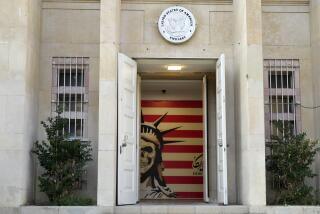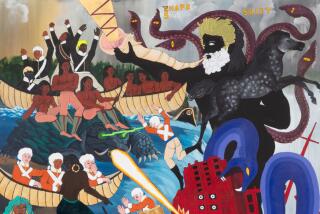Iran museum exhibition shows off Pop art collection
- Share via
TEHRAN — At the Museum of Contemporary Art here, 19-year-old Aristotle Qajari, whose father named him after the celebrated Greek philosopher and writer, was mesmerized by an art form that is considerably more recent — and completely new to him.
“I have not heard about Pop art yet,” said Qajari, an architecture student, drawing a sketch of Pop artist Roy Lichtenstein’s 1961 painting “Roto Broil.”
The modern, Western art is a new concept for many here in the Islamic Republic, said the young student, and many Iranians, preoccupied with everyday life, don’t have time to think about such issues.
“I don’t think our common people and even students are wealthy enough to think of Pop art,” he said.
Nonetheless, Qajari and other Iranian students are flocking to an extraordinary exhibition of more than 100 works of some of the world’s leading Modern and Pop artists, such as Andy Warhol, David Hockney, Lichtenstein and Jasper Johns.
Ironically, the Islamic Republic, considered one of the most anti-Western governments in the world, happens to be home to the most extensive collection of late-19th and 20th century Western art outside Europe and the United States.
It’s just that the collection — said to include possibly the best Jackson Pollock outside the U.S., as well as some Picassos, Kandinskys, Miros and Monets — has been kept out of sight for 30 years, locked up and gathering dust in the museum’s basement vault.
Censors deemed some of the works too provoking or un-Islamic to be on display. Some of Warhol’s provocative paintings, along with one by Francis Bacon of two men in bed, are not being exhibited. And daring pieces such as Renoir’s “Gabrielle a la Chemise Ouverte” had to remain in the basement as well, because her chemise was not buttoned up.
After Iranian news reports about the opening of the Pop Art & Op Art exhibition, Iranians and expatriates were quick to visit the museum in equal numbers, eyeing rare works such as Warhol’s iconic paintings of Mao Tse-tung, for instance, and Claes Oldenburg’s “Tea Bag.”
The works are carefully placed in chic-looking galleries in the museum, with each gallery holding works by two or three artists. Each is accessible through spiral corridors, which visitors are seen climbing up and down in a steady stream. Framed biographies of each artist, in Persian and English, hang neatly next to the works.
The collection was largely assembled during the last years of the ousted shah’s regime, when the 1970s oil boom pumped cash into the nation. The collection first went on display two years before the Islamic Revolution, reportedly being a smash hit when it opened in 1977.
A guide who identified herself only as Miss Payandeh said she was being flooded with questions from excited students about the exhibition and the Pop art scene of the 1950s and 1960s. Sometimes, she said, she has to educate some.
“Even art students sometimes have not heard about Chairman Mao and Chinese communism,” she said, pointing toward Warhol’s colorful paintings of the late leader.
And then, she said, there are more vexing questions.
“People ask irrelevant questions like, ‘How much is the price of these paintings, and are they genuine or not?’” she said.
Outside the museum, local families are seen strolling in the adjacent Laleh park. Payandeh said the exhibition, with its admission cost of 1,000 tomans, or about 80 cents, still tends to attract only a certain layer of society, such as art students and intellectuals, even though it’s been advertised in the press.
“If they are ready to pay 1,000 tomans, they are looking for realistic life-size pictures such as postcard landscapes,” the 25-year-old painting major said.
In the gallery hosting Jim Dine, two architecture students from Khayyam University in eastern Iran were examining his works and discussing the American Pop artist.
“If we had not been taught modern architecture and the new style of painting, then we would not be able to appreciate the color and new aesthetics,” 26-year-old Mohammad Azadi said. “I get solace by watching these paintings.”
Special correspondents Mostaghim reported from Tehran and Sandels from Beirut.
More to Read
Sign up for Essential California
The most important California stories and recommendations in your inbox every morning.
You may occasionally receive promotional content from the Los Angeles Times.









